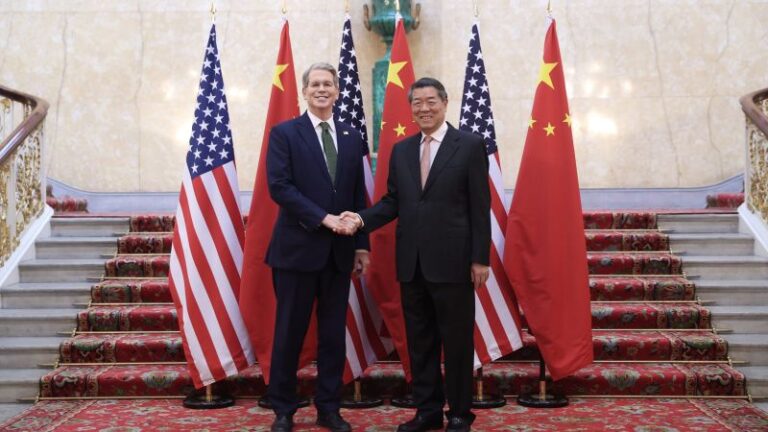CNN
—
At long last, the United States has reached a trade agreement with China.
Again.
After a testy war of words that escalated into a tit-for-tat restriction on key exports, American and Chinese officials this week met in the United Kingdom with a singular goal: Find a way to agree to what they had agreed to a month earlier in Geneva.
It appears the countries’ top trade negotiators have accomplished that. On Tuesday night, both Chinese and Trump officials said they had agreed to a framework to implement the consensus they reached in May, and the trade truce would be sent to their respective leaders for their approval.
Businesses, consumers and Wall Street investors will no doubt breathe a sigh of relief: Burdensome tariffs have raised significant anxiety, and easing trade barriers between the world’s two largest economies should lower costs and help inject some much-needed certainty into an economy that has been demonstrating some signs of strain.
But in reality, the trade truce – if that’s really what was accomplished this time around – is mostly just a return to the already-tense state of affairs from before April 2. Tariff rates from both countries remain historically high, and significant export restrictions remain in place. The United States has not opened its doors to China’s autos, nor is it going to sell its high-end AI chips anytime soon. And, in President Donald Trump’s parlance, China isn’t treating America much more “fairly” after this agreement than it did before.
Without a doubt, a trade agreement was much needed. After Trump’s April 2 “Liberation Day” announcements, tensions ran so high that trade between the United States and China came to an effective halt. A 145% tariff on most Chinese imports made the math impossible for US businesses to buy virtually anything from China, America’s second-largest trading partner.
US Treasury Secretary Scott Bessent, America’s chief negotiator in both trade talks with China, said previous tariff levels were “unsustainable.”
On May 12, delegates from China and the United States announced they would significantly roll back their historically high tariffs on one another. Economists pared back their recession forecasts, and moribund consumer confidence rebounded.
But Trump and his administration in recent weeks grew increasingly hostile toward China, accusing the country of breaking the promises it made in mid-May. China similarly said the United States failed to live up to its obligations under the Geneva agreement.
The Trump administration had expected China to lift restrictions on rare-earth materials that are critical components for a wide range of electronics, but China has only very slowly allowed them to return to the open market, causing intense displeasure inside the Trump administration and prompting a series of export restrictions on US goods to China, three administration officials told CNN last month.
China has a virtual monopoly on rare earths, without which cars, jet engines, contrast dye used in MRI machines and some cancer drugs cannot be manufactured. Trump told reporters Friday that Chinese President Xi Jinping had agreed to allow exports of rare earth minerals products to begin, but industry analysts said the crucial materials had not been flowing to the United States as they once had.
If both countries satisfy the terms of the agreement this time around, the de-escalation should prevent the direst warnings about the trade war, including potential pandemic-level shortages.
Despite the good vibes, the United States and China remain in an economic standoff.
The Trump administration – and the Biden administration before it – have maintained that Chinese companies are more than happy to sell inexpensive products to the US market but that China places significant restrictions on US businesses operating in the country and encourages Chinese companies to steal American intellectual property. China has long disputed those claims.
Trump, in his first term, raised tariffs on China based on national security concerns. Biden maintained many of those tariffs and doubled down on some.
But the second Trump administration has taken trade barriers to an unprecedented level. It has placed a 10% universal tariff on virtually all goods coming into the United States. It put in place an additional 20% tariff on Chinese goods in an effort to get China to take action to reduce the flow of fentanyl over the US border. Both of those extraordinary tariffs remain in place on most Chinese goods, with the exception of some products like electronics.
In addition, the White House closed the so-called de minimis exemption that allowed packages with a value of under $800 to come into the United States tariff-free. Hefty new tariffs remain in place on small packages, undermining the business models of Chinese ecommerce giants Shein and Temu.
The compounding tariffs create significant trade barriers with America’s second-largest trading partner, raising prices for American businesses and consumers with no easy fixes or clear market alternatives. Some gigantic companies, such as Apple, have complex supply chains that can withstand some of the price pressures. But even Apple, which has said it would ship most US iPhones from India as Chinese tariffs rise, said it would face a $900 million quarterly cost increase because of tariffs – at their current levels, not at the sky-high 145% rate.
So a trade truce may be better than the alternative – if it lasts this time.


